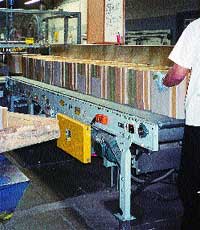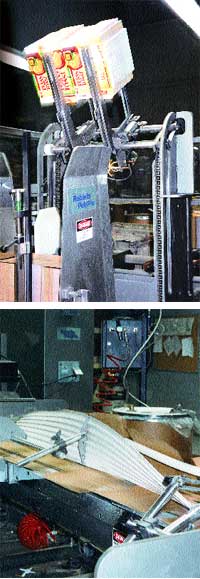Folder/gluer yields Texas-sized benefits
January 29, 2014
In October, '00, when Chicago-based Crane Carton Co. LLC was acquired by Caraustar Industries, Inc., the transition was nearly seamless. Says founder and former CEO of Crane, Alan Crane, now president of Caraustar Chicago Carton, "If we hadn't told our employees that we had sold the company, they wouldn't even have known."
The same philosophy and values that propelled Crane Carton to $41 million in revenues in '99 continue to flourish under the new ownership, he says. "When you talk to our employees, you get the idea that they are dedicated. We get jobs done while other people are still thinking about how to do them."
|
Large, heavy stacks of printed carton stock are supplied to the stack turner via an infeed conveyor, fed by an operator. |
Part and parcel of the carton converting company's quick reaction time is its willingness to be on the cutting edge of new technology. In early '01, due to its reputation as having one of the best finishing departments in the country, Crane relates, Caraustar Chicago was asked by Robert's to beta-test its innovative new 4104 SuperGluer® folder/gluer with zero-defect technology, coupled with its Model 8500 stack turner, Model 540 prefeeder and Model 7500 turntable. The entire solution, known as the FinishLine®, was refined over a nine-month period through trial and error to the extent that today "it can outproduce anything" when working with those jobs for which it is best-suited, Crane says.
Among these jobs, the cartons it produces for Marzetti's New York™ Brand Texas Toast epitomize the enhanced productivity Caraustar Chicago has been able to achieve with the SuperGluer for long-run carton-finishing jobs.
Uncompromising quality
Based in Columbus, OH, T. Marzetti Co., a division of Lancaster Colony Corp., produces specialty foods, such as salad dressings, sauces, frozen baked goods, dips and more for both retail and foodservice venues. According to company lore, upon founding the business in 1896, Teresa Marzetti–an immigrant from Florence, Italy–vowed, "We will start a new place and serve good food. At a profit if we can, at a loss if we must, but we will serve good food."
One of the most popular items on Marzetti's menu today is its New York Brand Texas Toast, which was ranked No. 1 in Frozen Food Age magazine's '01 compilation of the top five U.S. frozen bread, roll and biscuit brands. The toast is offered in eight varieties, among them cheese and garlic flavors, as well as "lite" versions, available in sizes ranging from 8 oz to 22.5 oz. In total, Marzetti offers 10 stockkeeping units–all of which are packaged in cartons converted by Caraustar Chicago.
And, relates Alan Crane, not only does T. Marzetti still adhere to its founder's commitment to uncompromising quality when it comes to product taste, but the company also "prides itself on the quality of its packaging," he says.
|
Large, heavy stacks of printed carton stock are supplied to the stack turner via an infeed conveyor, fed by an operator. |
Therefore, when Caraustar Chicago was able to double the speed at which it produces the toast cartons using the SuperGluer, without threatening the integrity of the packaging, both packager and converter reaped the rewards. "We were able to increase our efficiency and productivity on a dramatic basis," says Crane, "which is always a help to the customer, because they share in the savings."
New technology needs tweaking
The Model 4140 SuperGluer modular folder/gluer relies on a new technology that eliminates the top-belt carrier used with conventional folder/gluers, replacing it with a low-pressure vacuum-assisted carrier system that secures and controls cartons during operation. Claims Robert's, this construction, which reduces moving parts by approximately 80 percent, allows the machine to operate at "exceptional" line speeds, with much less maintenance and downtime than with conventional gluers.
When Caraustar Carton took possession of a six-module version of the machine, Crane says there were still bugs to be worked out. "But," he adds, "you could see the potential. So we stuck with it."
One of the biggest concerns, according to Caraustar Chicago finishing manager Luis Martinez, was getting the glue system to work properly. Because of the tremendous speed of the machine, the glue applicator's plunger had to be equipped to react virtually in milliseconds, using glue with the right viscosity. After experimentation, Caraustar selected a W.H. Leary glue applicator, combined with glue from Aabbitt Adhesives, selected based on tests performed by the glue supplier. Using a 0.5mm orifice, as opposed to the 20mm size used for its conventional folder/gluers, the converter also reduced its glue consumption by half.
Once in operation, the SuperGluer took on the Marzetti's Texas Toast cartons, due to the job's long run lengths. Constructed of recycled paperboard, the stock is first printed on one of Caraustar's three MAN Roland 7C-plus-coater offset presses, which include one 56-in. and two 40-in. models. Depending upon the product variety, either six or seven colors plus an aqueous coating are used to decorate the cartons. Printed stock is then die-cut on one of four Bobst blankers, after which it is ready for folding and gluing.
'Unmatched' speed
While Crane admits that the SuperGluer is not suitable for all carton jobs, he says that for particular applications, such as large runs, and certain styles that include compound folds, its speed is unmatched.
|
At top, cartons are transferred from the folder/gluer to the compression module, which pushes down on glued cartons to ensure a secure bond, and then shingles them. Above, shingled cartons are carried to the case packer, after being rotated to the correct position via the turntable. |
Robert's explains that due to the machine's low-pressure vacuum system and the elimination of the friction and drag associated with top-carrier belts and ball bearings, it can operate at speeds up to 2,300 fpm. For jobs such as Marzetti's–which involves carton sizes from 3 x 11/16 x 53/8 to 51/4 x 31/2 x 9 in.–this means that a previous output speed of 40,000 to 60,000 cartons/hr has now been increased to 80,000 to 120,000 cph, depending upon carton size.
Taking the bearings and belts out of the equation also means that cartons travel much straighter, observes Crane. "You don't get twisted lines," he says, "and carton scuffing and crushing are eliminated."
Downtime is greatly reduced through the machine's design, as well. Because cartons ride openly and securely on top, clearing jams is a fast and easy process, taking as little as 30 seconds, says Crane.
Jams are also minimized through the use of the machine's Zero-Defect System. The programmable logic control system utilizes safety and jam sensors to spot out-of-position cartons and, upon identifying them, shuts down the machine in a controlled fashion until the cartons can be cleared. In the event of a jam, downstream modules continue to carry cartons to the compression module. This eliminates the need for inspection for properly compressed cartons, and reduces carton spoilage, says Robert's.
Beyond addressing jamming issues, the Zero Defect System is also used to start and stop the system without operator intervention. During machine startups, the SuperGluer is programmed to automatically clear off cartons by way of an optional carton ejector that eliminates the potential for misglued cartons. During programmed stops, the Zero Defect System enables the shingle thickness to be decreased gradually, while the compression module continues to operate.
Inspecting folded and glued cartons before they exit the machine is a W.H. Leary Series 8000 inspection system that checks for correct bar codes and glue patterns in-line. The system includes a user-friendly interface, a fully interactive screen, multiple scanning options, pattern recognition, automatic carton rejection, and data collection capabilities.
Feeding with flair
At the front end of Caraustar Chicago's finishing line is another Robert's PolyPro machine that breaks new ground. Typically, before being fed to a folder/gluer, stacks of printed and die-cut carton stock are manually flipped over from a print-side-up position, to a print-side-down orientation. With Robert's Model 8500 stack turner, large, heavy stacks of carton stock, supplied to the stack turner via an infeed conveyor manually fed by an operator, are inverted in a single motion through mechanical means and are automatically squared and aligned for the prefeeder. According to Crane, the stack turner requires less operator skill and also "reduces the risk of carpal tunnel and other repetitive-motion injuries."
The stack turner responds to a cue from the next piece of equipment on the line–a Robert's prefeeder–to load new carton stock. The Model 540 prefeeder is said by Robert's to increase the folder/gluer's line speeds from 25 percent to 40 percent, through the use of a continuous-belt design that accommodates a range of adjustments without changing belt tension.
Synchronization of FinishLine components is accomplished through the SuperGluer's operator interface terminal, which allows all variables affecting production to be programmed and viewed on-screen. This lets the operator adjust relative speed, monitor machine setpoints and control overall system performance from one place.
Setup is also programmed through the terminal. According to Martinez, while changeover from one previously programmed job to another takes approximately just four minutes, programming the parameters for a completely new job can take from one to two hours.
Upon completion of folding and gluing, cartons are carried to the casing operation on Robert's Model 7500 turntable. The carton-turning device provides a continuous flow of shingled cartons and, with bi-directional operation capabilities, enables cartons to be packaged glue-seam-up or seam-down. Case packing is performed by a Jagenberg Jackpack, which, Martinez says, has had no difficulty keeping pace with the FinishLine.
Superior performance
While being on the leading edge–or, as some like to call it, "the bleeding" edge–of new technology can be a risky proposition, it can often pay off in ways unimagined. Among the benefits cited by Crane from its use of the new FinishLine are a reduction in glue usage of up to 50 percent, less than 0.25 percent spoilage during case packing and the ability to finish nearly 2 million cartons/day.
"The quality of the machine comes from its engineering," says Crane. "The way it performs is superior to any other gluer."
More information is available:
Carton converting: Caraustar Chicago Carton, 773/722-0555. Circle No. 214.
Infeed conveyor, prefeeder, stack turner, folder/gluer, turntable: Robert's PolyPro, Inc., 704/588-1794. Circle No. 215.
Glue applicator, inspection system: W.H. Leary Co., Inc., 800/272-1671. Circle No. 216.
Adhesives: Aabbitt Adhesives, Inc., 773/227-2700. Circle No. 217.
Presses: MAN Roland, 630/920-2000. Circle No. 218.
Die-cutters: The Bobst Group, 973/226-8000. Circle No. 219.
Case packer: Jagenberg, Inc., 860/741- 2501. Circle No. 221.
About the Author(s)
You May Also Like





